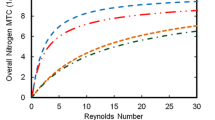Abstract
In this study, the axial flow cyclone used in Tsai et al. (2004) was further tested for the collection efficiency of both solid (NaCl) and liquid (OA, oleic acid) nanoparticles. The results showed that the smallest cutoff aerodynamic diameters achieved for OA and NaCl nanoparticles were 21.7 nm (cyclone inlet pressure: 4.3 Torr, flow rate: 0.351 slpm) and 21.2 nm (5.4 Torr, 0.454 slpm), respectively. The collection efficiencies for NaCl and OA particles were close to each other for the aerodynamic diameter ranging from 25 to 180 nm indicating there was almost no solid particle bounce in the cyclone. The 3-D numerical simulation was conducted to calculate the flow field in the cyclone and the flow was found to be nearly paraboloid. Numerical simulation of the particle collection efficiency based on the paraboloid flow assumption showed that the collection efficiency was in good agreement with the experimental data with less than 15% of error. A semi-empirical equation for predicting the cutoff aerodynamic diameter at different inlet pressures and flow rates was also obtained. The semi-empirical equation is able to predict the cutoff aerodynamic diameter accurately within 9% of error. From the empirical cutoff aerodynamic diameter, a semi-empirical square root of the cutoff Stokes number, \(\sqrt {St_{50}^\ast}\), was calculated and found to be a constant value of 0.241. This value is useful to the design of the cyclone operating in vacuum to remove nanoparticles.
Similar content being viewed by others
References
Biswas P., Flagan R.J. (1988) Particle trap impactor. Aerosol Sci. 19: 113–121
Blachman M.W., Lippmann M. (1974) Performance characteristics of the multicyclone aerosol sampler. Am. Ind. Hyg. Assoc. J. 35: 311–326
Boysan F., Ewan B.C.R., Swithenbank J., Ayers W.H. (1983) Experimental and theoretical studies of cyclone aeparator aerodynamics. IChemeE. Symp. Series 69: 305–320
Harwood R., Slack M. (2002) CFD analysis of a cyclone. QNET-CFD Network Newsletter. 1: 25–27
Hinds W.C. (1999) Aerosol Technology. Wiley, New York, p126
Hoekstra A.J., Derksen J.J., Van Den Akker H.E.A. (1999) An experimental and numerical study of turbulent swirling flow in gas cyclones. Chem. Eng. Sci. 54: 2055–2065
Hsu Y.D., Chein H.M., Chen T.M., Tsai C.J. (2005) Axial flow cyclone for segregation and collection of ultrafine particle: Theoretical and experimental study. Environ. Sci. Technol. 39: 1299–1308
Liu B.Y.H., Rubow K.L. (1984) A new axial flow cascade cyclone for size characterization of airborne particulate matter. In: Liu B.Y.H., Pui D.Y., Fissan H.J. (eds) Aerosols. Elsevier, Amsterdam, pp. 115–118
Maynard A.D. (2000) A simple model of axial flow cyclone performance under laminar flow conditions. J. Aerosol Sci. 31: 151–167
Patankar S.V. (1980) Numerical Heat Transfer and Fluid Flow. Hemisphere Publishing Co, Washington
Schmidt S., Thiele F. (2002) Comparison of numerical methods applied to the flow over wall-mounted cubes. Inter. J. Heat & Fluid Flow. 23: 330–339
Schmidt S., H.M. Blackburn, M. Rudman & I. Sutalo, 2003. Simulation of turbulent flow in a cyclonic separator. 3rd International conference on CFD in the Minerals and Process Industries CSIRO, Melbourne, Australia, 10–12 December 2003, p. 365–369
Tsai C.J., Shiau H.G., Lin K.C., Shih T.S. (1999) Effect of deposited particles and particle charge on the penetration of small sampling cyclones. J. Aerosol Sci. 30: 313–323
Tsai C.J., Lin T.I. (2000) Particle collection efficiency of different impactor designs. Sep. Sci. Technol. 35: 2639–2650
Tsai C.J., Cheng Y.H. (1995) Solid particle collection characteristics on impaction surfaces of different designs. Aerosol Sci. Technol. 23: 96–106
Tsai C.J., Chen D.R., Chein H.M., Chen S.C., Roth J.L., Hsu Y.D., Li W., Biswas P. (2004) Theoretical and experimental study of an axial flow cyclone for fine particle removal in vacuum conditions. J. Aerosol Sci. 35: 1105–1118
Vaughan N.P. (1988) Construction and testing of an axial flow cyclone pre-separator. J. Aerosol Sci. 19: 295–305
Weiss Z., Martinec P., Vitek J. (1987) Vlastnosti Dulnibo Prachu A Zaklady Protiprasne Techniky. SNTL, Prague
Xiang R.B. & K.W. Lee, 2004. The flow pattern in cyclones with different cone dimensions and its effect on separation efficiency. Abstract, EAC 2004, Budapest, Hungary, Sep. 6–10, p. 289–290
Zhu Y., Lee K.W. (1999) Experimental study on small cyclones operating at high flowrates. J. Aerosol Sci. 30: 1303–1315
Acknowledgement
Authors would like to thank for the financial support of this project by Taiwan National Science Council (NSC 94-2211-E-009-001).
Author information
Authors and Affiliations
Corresponding author
Rights and permissions
About this article
Cite this article
Chen, SC., Tsai, CJ. An axial flow cyclone to remove nanoparticles at low pressure conditions. J Nanopart Res 9, 71–83 (2007). https://doi.org/10.1007/s11051-006-9152-z
Received:
Accepted:
Published:
Issue Date:
DOI: https://doi.org/10.1007/s11051-006-9152-z




